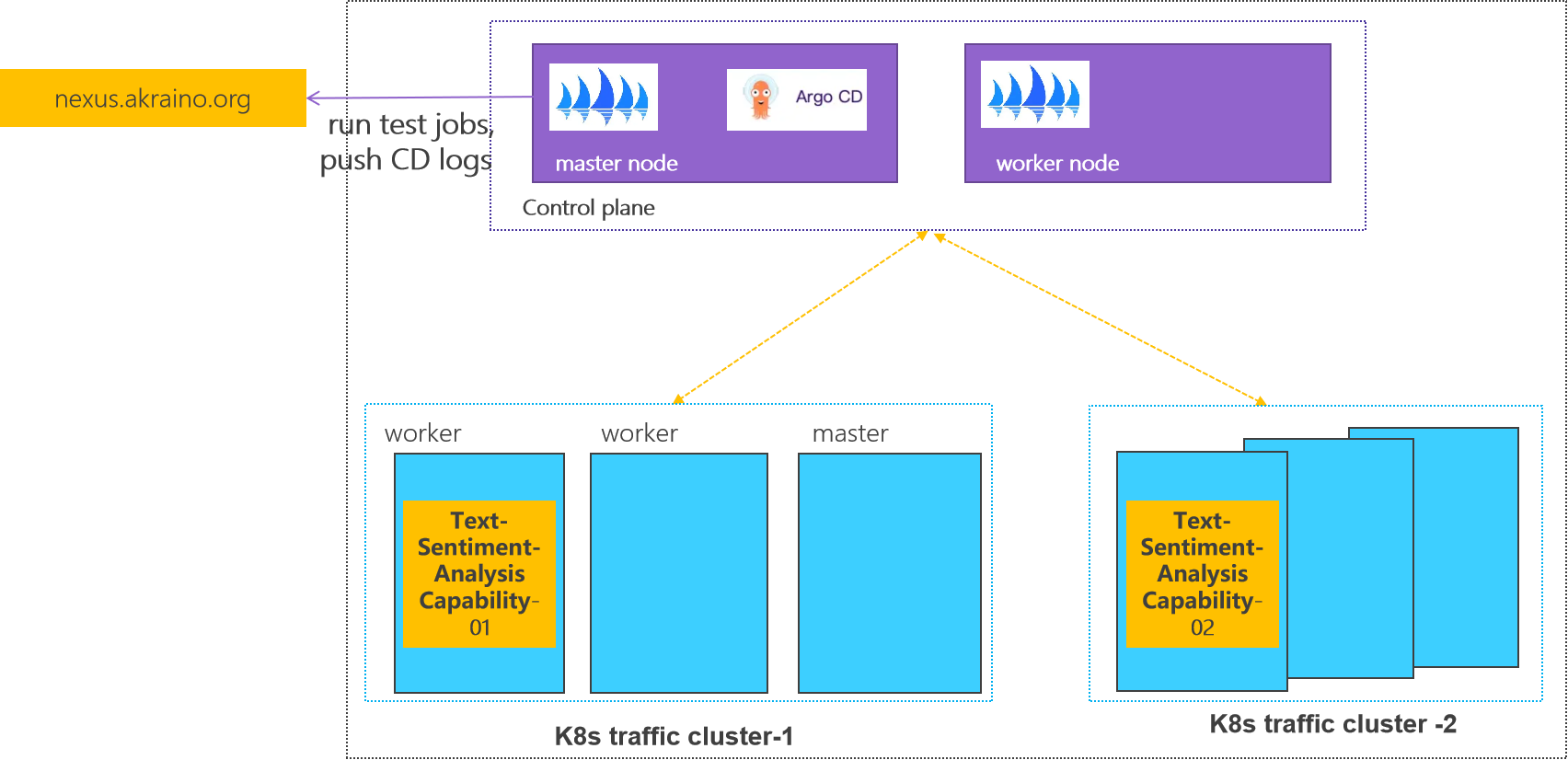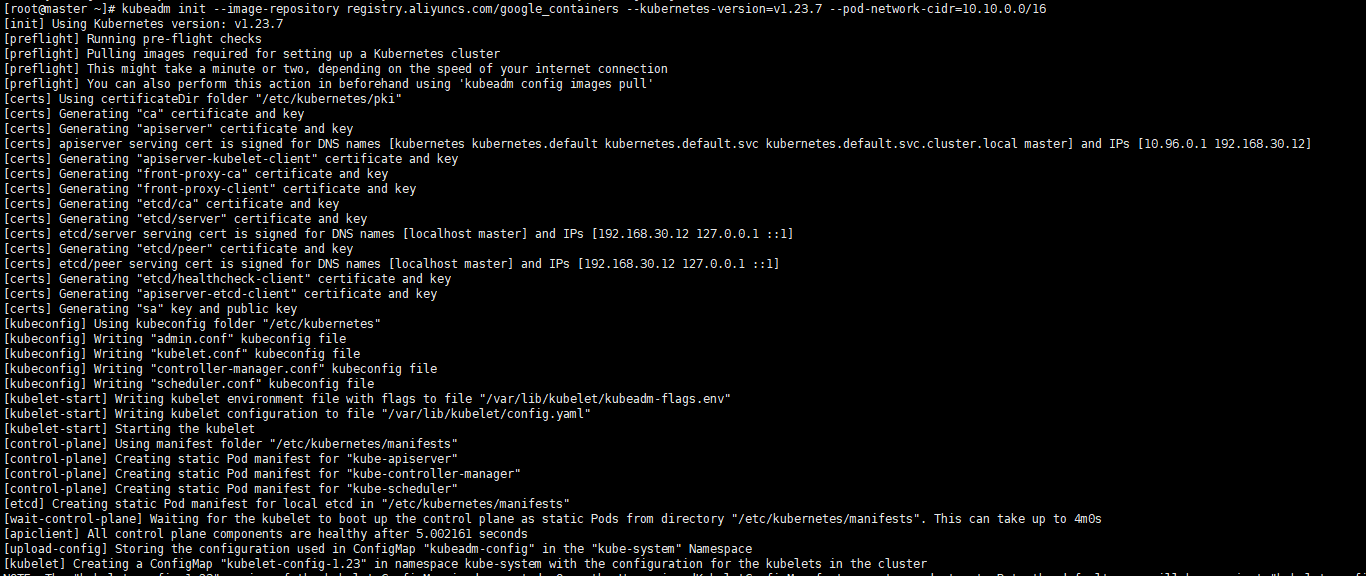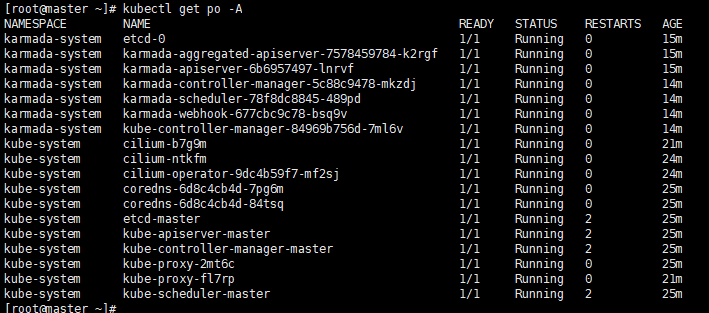| Table of Contents |
|---|
@MIGU 补充应用安装相关部分
@huawei 补充控制面相关部分
Introduction
...
This document describes steps required to deploy a sample environment and test for CFN (Computing Force Network) Ubiquitous Computing Force Scheduling Blueprint.
Deployment Architecture
Control plane: one k8s cluster is deployed in private lab.
Traffic plane: two K8s clusters are deployed in private lab.
Pre-Installation Requirements
...
kubeadm-1.23.7
kubectl-1.23.7
N/A
- Database Perequisites
schema scripts: N/A
...
0 Environmental description
Two centos At least two CentOS machines are required, one as the master node and the other as the worker node. The installed k8s version is 1.23.7.
There will be a comment like #master in front of each bash command, which is used to indicate which type of machine the command is used on. If there is no comment, the bash command needs to be executed on both types of machines
This document contains the operation and execution process, you can compare the screenshots of the document during the installation process.
1 Basic environment preparation
...
Preparing the basic environment to ensure the normal execution of subsequent operations.
1.1 Confirm your OS
Confirm that the operating system of the current machine is CentOS 7 .
Execute command
| Code Block | ||||||
|---|---|---|---|---|---|---|
| ||||||
cat /etc/redhat-release |
...
If the name is long, it is recommended to use a combination of letters and dashes, such as "aa-bb-cc", here directly set to master and worker1.
Execute command
| Code Block | ||||||
|---|---|---|---|---|---|---|
| ||||||
# master hostnamectl set-hostname master hostnamectl # worker hostnamectl set-hostname worker1 hostnamectl |
...
The changed host name needs to take effect after reboot.
Execute command
| Code Block | ||||||
|---|---|---|---|---|---|---|
| ||||||
reboot |
1.3 Set address mappinmapping
Set address mapping, and test the network.
Execute command
| Code Block | ||||||
|---|---|---|---|---|---|---|
| ||||||
cat <<EOF>> /etc/hosts
${YOUR IP} master
${YOUR IP} worker1
EOF
ping master
ping worker1 |
...
The main content is to install docker-ce, and configure the cgroup driver of docker as systemd, confirm the driver.
2.1 Uninstall old docker
Execute command
...
| Code Block | ||||||
|---|---|---|---|---|---|---|
| ||||||
# master kubeadm init --image-repository registry.aliyuncs.com/google_containers --kubernetes-version=v1.23.7 --pod-network-cidr=10.10.0.0/16 |
Execute screenshot
Let kubectl take effect
...
When you have the join statement, copy it and execute it on the worker node
Note that if an error occurs and you need to re-init, you need to execute the following statement first to ensure that kubeadm is re-executed normally
...
| Code Block | ||||||
|---|---|---|---|---|---|---|
| ||||||
kubectl get po -A |
Execute screenshot
7 Propagate a deployment by Karmada
...
Before propagating a deployment, make sure the worker cluster is already working properly And get the latest config currently running
In the following steps, we are going to propagate a deployment by Karmada. We use the installation of nginx as an example
...
Here we add the working node cluster through push mode
It is worth noting that /root/.kube/config is Kubernetes host config and the /etc/karmada/karmada-apiserver.config is karmada-apiserver config
Execute command
| Code Block | ||||||
|---|---|---|---|---|---|---|
| ||||||
kubectl karmada join worker-cluster--kubeconfig /etc/karmada/karmada-apiserver.config join ${YOUR MEMBER NAME} --cluster-kubeconfig=prod --${YOUR MEMBER CONFIG PATH} --cluster-context=prod |
...
${YOUR CLUSTER CONTEXT} |
Here is example command for your information: kubectl karmada --kubeconfig /etc/karmada/karmada-apiserver.config join member1 --cluster-kubeconfig=/root/.kube/member1-config --cluster-context=kubernetes-admin@kubernetes
--kubeconfig specifies the Karmada'skubeconfigfile and the CLI- --cluster-kubeconfig
specifies the member's config. Generally, it can be obtained from the worker cluster in "/root/.kube/config" --cluster-context the value of current-context from --cluster-kubeconfig
If you want unjoin the member cluster, just change the join to unjoin: kubectl karmada --kubeconfig /etc/karmada/karmada-apiserver.config unjoin member2 --cluster-kubeconfig=/root/.kube/192.168.30.2_config --cluster-context=kubernetes-admin@kubernetes
check the members of karmada
Execute command
| Code Block | ||||||
|---|---|---|---|---|---|---|
| ||||||
kubectl --kubeconfig /etc/karmada/karmada-apiserver.config get clusters |
7.2 Create nginx deployment in Karmada
deployment.yaml are obtained through here https://github.com/karmada-io/karmada/tree/master/samples/nginx
Execute command
| Code Block | ||||||
|---|---|---|---|---|---|---|
| ||||||
kubectl create -f /root/sample/nginx/deployment.yaml --kubeconfig /etc/karmada/karmada-apiserver.config
kubectl get deployment --kubeconfig /etc/karmada/karmada-apiserver.config |
7.3 Create PropagationPolicy that will propagate nginx to member cluster
propagationpolicy.yaml are obtained through here https://github.com/karmada-io/karmada/tree/master/samples/nginx
Execute command
| Code Block | ||||||
|---|---|---|---|---|---|---|
| ||||||
kubectl get po -A |
...
create -f /root/sample/nginx/propagationpolicy.yaml --kubeconfig /etc/karmada/karmada-apiserver.config |
7.4 Check the deployment status from Karmada
| Code Block | ||||||
|---|---|---|---|---|---|---|
| ||||||
kubectl get po -A |
7.2 Create nginx deployment in Karmada.
| Code Block | ||||||
|---|---|---|---|---|---|---|
| ||||||
--kubeconfig /root/.kube/member1-config kubectl get po -A --kubeconfig /root/.kube/member2-config |
Reference
https://lazytoki.cn/index.php/archives/4/
...
Uninstall Guide
Troubleshooting
1. Network problem: the working cluster uses the default communication mode of calico, and the access between nodes is blocked; After many attempts, calico vxlan is feasible and flannel is feasible at present;
2. Disaster recovery scenario scheduling, test scenario 2, requires the karmada control plane to install the deschedule component;
Maintenance
Blue Print Package Maintenance
- Software maintenance: N/A
- Hardware maintenance:N/A
...







